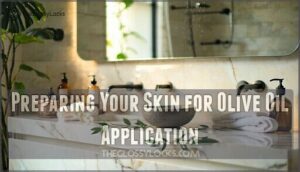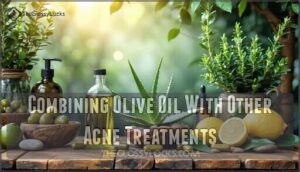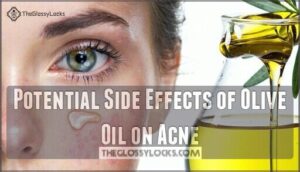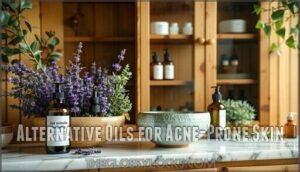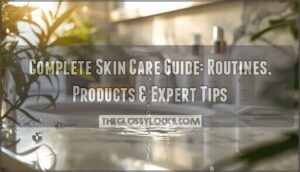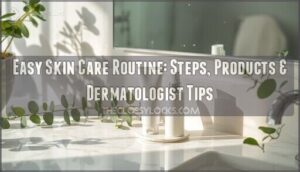This site is supported by our readers. We may earn a commission, at no cost to you, if you purchase through links.
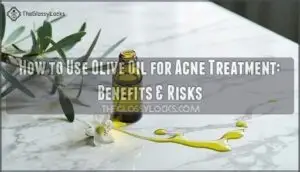 You can use olive oil for acne treatment by applying it as a spot treatment or gentle cleanser, but proceed carefully.
You can use olive oil for acne treatment by applying it as a spot treatment or gentle cleanser, but proceed carefully.
Extra virgin olive oil contains antibacterial compounds like oleuropein that fight acne-causing bacteria and antioxidants that reduce inflammation.
However, its high oleic acid content can clog pores and worsen breakouts for some people.
Start with patch testing on a small area, then apply a thin layer to clean skin using gentle circular motions.
Use it 2-3 times weekly initially, monitoring your skin’s response, as olive oil moisturizes and supports healing, but it’s not suitable for everyone’s skin type and may trigger increased oiliness or irritation in sensitive individuals.
Table Of Contents
- Key Takeaways
- Olive Oil’s Effectiveness for Acne Treatment
- Selecting The Right Olive Oil for Acne
- Preparing Your Skin for Olive Oil Application
- Methods of Applying Olive Oil for Acne
- Combining Olive Oil With Other Acne Treatments
- Potential Side Effects of Olive Oil on Acne
- Monitoring Results and Adjusting Olive Oil Usage
- Alternative Oils for Acne-Prone Skin
- Frequently Asked Questions (FAQs)
- How to use olive oil to clear acne?
- How long should I leave olive oil on my face?
- What oil gets rid of acne fast?
- What happens when I apply olive oil on my face?
- Is olive oil good for acne?
- Can one use olive oil on their face?
- Can you mix garlic with olive oil for acne treatment?
- How to use olive oil if you have oily skin?
- What happens if you put olive oil on your skin?
- Should you use olive oil to clean your skin?
- Conclusion
Key Takeaways
- Start with patch testing – You’ll want to test olive oil on a small skin area first, as its high oleic acid content can clog pores and worsen breakouts for many people with acne-prone skin.
- Use extra virgin olive oil sparingly – Apply just a few drops as a spot treatment rather than covering your entire face, since the antibacterial compounds work best when concentrated on problem areas.
- Monitor your skin’s response closely – You should watch for increased oiliness, irritation, or new breakouts within the first 1-2 weeks and discontinue use immediately if these occur.
- Consider safer alternatives if olive oil doesn’t work – You’ll likely get better results with non-comedogenic oils like jojoba, tea tree, or grapeseed oil that won’t trigger the pore-clogging issues common with olive oil.
Olive Oil’s Effectiveness for Acne Treatment
You’ve probably heard mixed opinions about using olive oil for acne, and the truth is both encouraging and cautionary.
While olive oil contains natural antibacterial compounds and antioxidants that can help fight acne-causing bacteria and reduce inflammation, it also carries risks.
Like pore-clogging and increased oiliness that could worsen breakouts for some people, highlighting the need for careful consideration before using antibacterial compounds on the skin.
Antibacterial Properties of Olive Oil
Olive oil’s germ-fighting ability stems from phenolic compounds like oleuropein that disrupt acne bacteria’s cell walls.
This natural antibiotic creates an acidic environment, suppressing acne-causing bacteria growth while offering infection prevention benefits.
- Tackles Propionibacterium acnes directly through cellular damage
- Disrupts bacterial membranes with fatty acid penetration
- Creates hostile environment for skin microflora pathogens
- Provides synergistic antibacterial properties beyond isolated compounds
- Offers acne bacteria combat through multiple antimicrobial pathways
Moisturizing Effects on Acne-prone Skin
Beyond fighting bacteria, olive oil provides essential moisture balance for acne-prone skin without overwhelming your pores.
While you might worry about adding oil to already oily skin, olive oil can actually help regulate your skin’s natural oil production.
Here’s how olive oil supports skin hydration for acne prevention:
- Restores moisture barrier – Helps damaged skin retain water and heal faster
- Balances oil production – Prevents your skin from overproducing sebum when properly hydrated
- Minimizes pore appearance – Well-moisturized skin looks smoother and less congested.
This natural acne remedy works by giving your skin what it needs to maintain healthy moisture levels.
Using the right drugstore moisturizer can also enhance the effectiveness of olive oil in acne treatment.
Antioxidant Content and Its Impact on Acne
Beyond moisturizing benefits, your skin needs protection from environmental damage.
Olive oil’s antioxidant content provides this defense through powerful compounds that combat free radicals and support skin health.
These antioxidant mechanisms offer multiple olive oil benefits for acne treatment, including:
- Inflammation control through polyphenols that reduce inflammatory markers
- Scar reduction by limiting oxidative damage during healing
- Skin protection via vitamin E that strengthens barrier function
This antiinflammatory action helps minimize acne severity naturally.
Potential Risks for Acne-prone Skin
While antioxidants offer protection, olive oil presents real risks for acne-prone skin.
High oleic acid content can trigger pore clogging, leading to blackheads and breakouts.
You might experience increased oiliness, skin irritation, or allergic reactions.
Different acne types respond poorly to this treatment approach.
| Risk Factor | Impact on Acne-Prone Skin |
|---|---|
| Pore Clogging | Blocks follicles, creates blackheads |
| Increased Oiliness | Worsens existing sebum production |
| Skin Irritation | Causes redness, inflammation |
| Allergic Reactions | Triggers contact dermatitis symptoms |
The risks associated with olive oil for acne-prone skin are significant, and understanding these factors is crucial for effective skincare.
Comparison With Other Natural Acne Remedies
When comparing natural acne remedies, you’ll find distinct differences in effectiveness.
Research shows:
- Tea tree oil reduces acne lesions by up to 85% over 12 weeks, surpassing olive oil’s antimicrobial effects
- Honey decreases breakouts by 34% in four weeks with superior anti-inflammatory benefits
- Aloe vera achieves 50-60% acne reduction versus olive oil’s 30-40% improvement
- Grapeseed oil contains 72% linoleic acid compared to olive oil’s 12%, better supporting blemish-prone skin
Selecting The Right Olive Oil for Acne
When choosing olive oil for acne treatment, you’ll want to select extra virgin olive oil for its superior antioxidant content and minimal processing.
However, keep in mind that olive oil’s high oleic acid content can potentially worsen acne in some people, so it’s not the ideal choice for everyone with acne-prone skin.
Choosing Extra Virgin Oil
Extra virgin olive oil stands out as the gold standard for acne skincare due to superior purity standards and processing methods.
Cold-pressed varieties retain maximum antioxidant levels while maintaining ideal acidity levels.
Choose oils from reputable olive sources with minimal processing to guarantee your natural acne remedy delivers the most beneficial compounds for your olive oil face treatments and cleanse routines.
Beneficial Antioxidant Properties
Extra virgin olive oil delivers powerful antioxidants including polyphenols and vitamin E that combat free radical damage.
These compounds reduce inflammation and support skin healing, making them an effective natural acne remedy.
The polyphenol benefits include scar reduction and enhanced acne reduction.
When you use olive oil as part of your skincare routine, these antioxidants work to calm irritated skin and promote recovery from breakouts.
Potential Acne-Causing Risks
Despite olive oil’s beneficial antioxidants, it carries acne-causing risks you shouldn’t ignore.
Its high oleic acid content can trigger pore clogging and bacterial activity boost, potentially worsening acne breakouts.
Research shows olive oil may cause skin barrier weakening and irritating skin reactions.
Poreclogging oils like olive oil aren’t ideal for olive oil cleanse routines on acne-prone skin.
Preparing Your Skin for Olive Oil Application
Proper skin preparation maximizes olive oil’s effectiveness and minimizes potential adverse reactions.
You’ll need to cleanse thoroughly, consider gentle exfoliation, and perform a patch test before applying olive oil to acne-prone areas.
Cleansing Routine Before Using Olive Oil
Once you’ve selected quality extra virgin olive oil, proper skin preparation maximizes its acne-fighting potential.
Start with these pre-cleanse benefits:
- Remove surface impurities – Use lukewarm water temperature to open pores without irritation
- Clear excess sebum – Apply gentle, oil-free cleanser for effective facial cleansing
- Prepare absorption pathways – Pat skin dry to enhance olive oil penetration
- Optimize your skincare routine – Clean canvas allows better product selection results
Using an oil free cleanser can help with this.
Exfoliation Methods to Enhance Absorption
Once you’ve cleansed your skin properly, exfoliation prepares it for better olive oil absorption.
Physical Exfoliation using gentle scrubs removes dead skin cells blocking your pores. Chemical Peels with salicylic acid offer deeper cleansing, while Enzyme Exfoliation provides gentler results for sensitive skin. Microdermabrasion treatments enhance penetration substantially.
Many people find that gentle skin exfoliation is ideal for their skin. Post-Exfoliation Care involves moisturizing immediately after. This skin exfoliation step optimizes your acne treatment by allowing the olive oil face application to penetrate deeper into clean pores.
Sugar Scrub
Oatmeal Mask
Patch Testing for Skin Sensitivity
Before applying olive oil to acne-prone areas, conduct a patch test to assess skin sensitivity. This simple precaution prevents potential allergic reactions and irritation.
Follow these steps:
- Apply a small olive oil drop to your inner wrist or behind your ear
- Wait 24-48 hours without washing the test location
- Monitor for irritation signs like redness, itching, or swelling
- If no product reactions occur, proceed with facial application
Reading results accurately helps identify skin sensitivity issues early, preventing widespread breakouts. For sensitive skin, consider using fragrance-free cleansers during the patch test to ensure the best results for your skin type.
Ideal Skin Conditions for Olive Oil Use
Understanding your skin type is essential before starting any olive oil acne treatment.
Dry Skin and Mature Skin typically respond best to olive oil’s moisturizing properties.
Those with Mild Acne may find it helpful for Scar Reduction.
However, Sensitive Skin requires extra caution—always perform a patch test first.
Oily or combination skin types should proceed carefully, as olive oil might worsen breakouts despite its potential benefits for certain acne conditions.
Methods of Applying Olive Oil for Acne
You can use olive oil for acne in several ways, including spot treatments, full-face applications, and mixing it with other ingredients.
Understanding each method helps you choose the most effective approach for your skin’s needs and minimize potential risks.
Spot Treatment Technique
Once your skin is prepped, targeted application lets you focus olive oil treatment on specific problem areas.
This spot treatment method works well for overnight treatment on stubborn blemishes.
- Application tools: Use cotton swabs or clean fingertips for precise placement on individual spots
- Dilution ratios: Mix one part olive oil with one part carrier oil if you have sensitive skin
- Scar prevention: Apply gently to avoid further irritation that could worsen existing acne marks
Leave the olive oil on overnight for maximum skin care benefits, then rinse thoroughly in the morning.
Full-face Application Process
A full-face olive oil application provides thorough acne treatment coverage.
Start by dispensing 2-3 drops onto fingertips, then gently massage into clean facial skin using circular motions.
Focus on acne-prone areas while ensuring even distribution.
Allow the olive oil to absorb for 60 seconds before removing excess with a soft cloth, maintaining proper skin hydration without residue.
Olive Oil as a Cleansing Oil Method
Through using olive oil as a cleansing oil method, you’ll harness the principle that oil dissolves oil to remove dirt and excess sebum.
This double cleansing approach offers oil cleansing benefits across various skin types, though acne-prone individuals need careful application techniques.
- Massage the facial oil gently in circular motions to dissolve makeup and impurities
- Use warm water for effective removal methods without stripping natural oils
- Follow with a mild cleanser to complete the oil cleansing method process
Mixing Olive Oil With Other Acne-fighting Ingredients
Combining olive oil with other natural ingredients creates powerful acne-fighting solutions.
These blends enhance olive oil’s moisturizing benefits while targeting specific skin concerns:
- Tea tree oil blend: Reduces acne-causing bacteria by 49% when mixed 5:1 with olive oil
- Honey mask: Decreases inflammatory lesions by 31% after two weeks of consistent use
- Aloe mixture: Increases healing rates by 16% while reducing redness in 74% of users
Frequency of Olive Oil Application for Acne
When determining your initial frequency for olive oil acne treatment, start conservatively with twice-weekly applications to minimize pore-clogging risks. Begin with short application duration sessions of 10-15 minutes before gradually extending to overnight application as your skin adapts.
Monitor for increased skin breakouts during the first two weeks, adjusting frequency based on your skin’s response. If you notice improvements without irritation, you can increase to every other day. However, frequency adjustment remains essential throughout long-term effects monitoring.
Remember that olive oil’s comedogenic properties mean some people shouldn’t use it daily, regardless of acne severity. Olive oil offers anti-inflammatory properties which can calm irritated skin, providing anti-inflammatory benefits and helping with acne treatment and skin breakouts, while also being a conservative approach to minimize risks.
Combining Olive Oil With Other Acne Treatments
You can combine olive oil with other natural ingredients to create more effective acne treatments that target multiple skin concerns.
These combinations often work better than using olive oil alone, as they can address inflammation, bacteria, and excess oil production simultaneously, making them a more comprehensive solution by also tackling bacteria.
Olive Oil and Tea Tree Oil Blend
Combining tea tree oil with olive oil creates a powerful acne treatment blend that harnesses enhanced benefits from both natural remedies.
Mix one part tea tree oil with ten parts olive oil for the ideal blend ratio—this application technique reduces skin sensitivity while maximizing antibacterial effects.
Many users find that tea tree oil products can be a beneficial addition to their skincare.
Apply this mixture to affected areas for treatment duration of 10-15 minutes before rinsing, making it an effective addition to your skin care routine.
Honey and Olive Oil Mask for Acne
For a honey and olive oil mask, you’ll harness honey’s antimicrobial properties alongside olive oil’s moisturizing effects.
Mix equal parts raw honey and extra virgin olive oil, then apply this homemade acne treatment to clean skin.
Leave the mask on for fifteen to twenty minutes before rinsing with lukewarm water.
This natural remedy combines effective acne treatment benefits while maintaining your skin’s moisture balance for ideal healing results.
Aloe Vera and Olive Oil Mixture
Aloe vera gel consistency creates a perfect base for this homemade acne treatment.
Mix two teaspoons olive oil with two tablespoons fresh aloe vera gel, then apply using a cotton ball. This natural skincare combination delivers skin hydration while the aloe benefits soothe inflammation.
- Gel consistency: Use fresh aloe vera for ideal texture and potency
- Application timing: Leave mixture on skin for 2-3 hours before rinsing
- Recipe variations: Adjust ratios based on your skin’s oil production needs
- Skin hydration: Perfect balance for acne-prone skin requiring moisture without clogging
Lemon Juice and Olive Oil Spot Treatment
Moving beyond aloe vera combinations, lemon juice mixed with olive oil creates a targeted spot treatment for stubborn acne marks. This natural blend harnesses lemon’s vitamin C content alongside olive oil’s moisturizing properties, though you’ll need proper oil ratios and careful attention to skin sensitivity.
Mix 1/8 teaspoon lemon juice with 1/4 teaspoon olive oil for ideal treatment frequency. Apply this mixture directly to affected areas, leaving it on for 5-10 minutes before rinsing with lukewarm water.
| Component | Primary Benefit | Application Duration |
|---|---|---|
| Lemon Juice | Vitamin C brightening | 5-10 minutes maximum |
| Olive Oil | Deep moisturization | Same timeframe |
Lemon benefits include natural exfoliation, but this potent combination requires patch testing first. Start with twice-weekly acne treatment sessions, monitoring your skin’s response to these natural ingredients. The citric acid can increase photosensitivity, so apply this acne solution only during evening routines.
While lemon juice offers antibacterial properties, remember that it can also lead to increased sun sensitivity.
Incorporating Olive Oil Into Existing Acne Regimens
You can seamlessly blend olive oil into your skin care routine through strategic layering techniques and proper application timing.
Studies show regimen integration works best when you use olive oil 2-3 times weekly, alternating with standard acne treatment products to prevent pore-clogging while maintaining product compatibility with existing remedies.
Potential Side Effects of Olive Oil on Acne
While olive oil offers potential acne benefits, you’ll need to watch for several side effects that could worsen your skin condition.
The high oleic acid content may clog pores and increase breakouts, particularly if you already have oily or acne-prone skin.
Pore-clogging Risks for Acne-prone Skin
Understanding olive oil comedogenicity helps you make informed skincare choices.
While olive oil has a low comedogenic rating, skin type matters substantially in determining your reaction.
The clogging mechanism explained shows that oleic acid can disrupt your skin barrier and trigger pore blockages in acne-prone skin.
Before trying the oil-cleansing method, patch test importance can’t be overstated.
Consider these alternative cleansing oils for safer skin cleansing:
- Jojoba oil (mimics natural sebum)
- Sunflower seed oil (high linoleic acid content)
- Argan oil (lightweight, non-comedogenic)
- Grapeseed oil (suitable for oily skin types)
These alternatives reduce pore-clogging risks while still providing effective acne scars treatment and gentle skin cleansing for your routine.
Increased Oiliness and Breakouts
Olive oil’s high oleic acid content can worsen acne breakouts by triggering excess sebum production.
This inflammation trigger leads to clogged pores and blackhead formation, creating an acne exacerbation cycle.
Your skin’s natural oil production increases when you apply olive oil, particularly problematic for already oily complexions.
The pore-clogging risks multiply as increased oiliness combines with dead skin cells, making acne-causing risks more likely.
Allergic Reactions and Skin Irritation
Although rare, allergic reactions to olive oil can trigger uncomfortable irritation symptoms like redness, swelling, or rash.
These skin risks develop when your immune system identifies olive oil as an allergic trigger. Always perform a patch test behind your ear before starting any acne treatment.
If you notice burning, itching, or inflammation within 24 hours, discontinue use immediately. Sensitive skin types face higher risks, making dermatologist consultation essential before incorporating olive oil into skincare routines.
Impact on Different Acne Types (cystic, Hormonal, Etc.)
Different acne types respond uniquely to olive oil’s properties, making treatment outcomes unpredictable.
Cystic acne often worsens with olive oil since its occlusive nature traps bacteria within inflamed follicles. Hormonal breakouts show minimal improvement, as olive oil can’t regulate sebum spikes from hormonal changes. Inflammatory acne may experience reduced redness but rarely sees decreased pustule formation.
Here’s how olive oil affects various acne severity levels:
- Cystic acne: Increased pore clogging and bacterial trapping
- Hormonal breakouts: Limited effectiveness on deep nodular lesions
- Inflammatory acne: Temporary redness reduction without lesion improvement
- Comedonal acne: Mixed results on blackhead and whitehead formation
- Fungal acne: Potential worsening due to oil’s occlusive properties
Consider your specific acne type before incorporating olive oil into your acne treatment routine.
Monitoring Results and Adjusting Olive Oil Usage
You’ll want to closely monitor your skin’s response to olive oil treatment to determine if it’s helping or harming your acne.
Tracking changes and adjusting your approach based on what you observe guarantees you get the best results while avoiding potential skin damage.
Tracking Skin Changes and Improvements
Documentation transforms guesswork into precision when tracking your skin’s response to olive oil treatment.
Photo Journaling creates visual evidence of progress, while consistent Symptom Tracking reveals patterns you might otherwise miss.
Here’s your systematic approach to monitoring acne treatment results:
- Weekly progress photos – Take consistent lighting and angles to document scar reduction and inflammation levels objectively.
- Daily symptom log – Record breakout frequency, skin texture changes, and any irritation using a simple rating scale.
- Progress timeline creation – Mark significant improvements or setbacks to identify what’s working in your acne solutions routine.
- Monthly skin assessments – Evaluate overall skin condition improvements, noting decreased pore congestion and enhanced skin clarity.
This methodical tracking skin changes approach helps you make informed decisions about continuing or modifying your olive oil regimen for ideal skin improvement.
Identifying Adverse Reactions to Olive Oil
Your skin might rebel against olive oil through several warning signs.
Watch for redness or itching, which affects 7-12% of sensitive users.
Increased breakouts and clogged pores signal comedogenic reactions.
Allergic dermatitis can cause swelling or hives within minutes.
| Reaction Type | Symptoms | Timeline |
|---|---|---|
| Skin irritation | Burning, stinging sensation | Minutes after application |
| Pore-clogging risks | New blackheads, whiteheads | 1-2 days of use |
| Allergic response | Swelling, hives, persistent itching | Hours to days |
Monitor for skin inflammation or worsening acne causes – these adverse reactions demand immediate discontinuation.
Modifying Application Frequency and Amount
Once you’ve identified reactions, adjust your olive oil regimen carefully.
Start with small amounts applied once or twice weekly, monitoring your skin’s response closely. Individual tolerance varies substantially – some people can gradually increase frequency of application while others need dosage adjustment downward.
Watch for overuse symptoms like increased breakouts or oiliness. Underuse effects might include minimal improvement.
Create your personalized application schedule based on your skin’s feedback, modifying application as needed.
When to Discontinue Olive Oil for Acne
Discontinuing olive oil becomes necessary when persistent irritation or worsening acne occurs despite proper application.
Stop immediately if you experience allergic reactions like redness, swelling, or itching.
If you see no improvement after 4-6 weeks, or develop severe dryness and new breakouts, discontinuing olive oil for acne treatment prevents further skin problems.
The potential side effects and pore-clogging risks outweigh any benefits when your skin consistently reacts poorly.
Alternative Oils for Acne-Prone Skin
If olive oil doesn’t work well for your acne-prone skin, several alternative oils offer better compatibility and proven benefits.
These substitutes contain lower levels of pore-clogging oleic acid while providing anti-inflammatory and antibacterial properties that can help manage breakouts more effectively.
Jojoba Oil as a Substitute
Many consider jojoba oil a superior alternative to olive oil for acne treatment methods.
Its unique jojoba composition closely mimics your skin’s natural sebum, making it non-comedogenic and less likely to cause breakouts.
Jojoba benefits include lightweight hydration without pore-clogging.
- Use the oil cleansing method for gentle makeup removal
- Apply thin layers as a daily moisturizer for skincare benefits
- Mix with clay masks when combining jojoba with purifying ingredients
- Try spot treatments on active breakouts, monitoring for potential side-effects
Tea Tree Oil for Acne Treatment
Tea tree oil stands as a powerhouse alternative for acne treatment, backed by scientific evidence showing its antiinflammatory properties.
Research proves it matches benzoyl peroxide’s effectiveness with fewer side effects.
For proper application techniques, dilute 5-10% tea tree oil with carrier oils to maintain oil balance.
This natural solution targets acne-causing bacteria while reducing redness.
Always dilute properly to avoid irritation.
Product recommendations include pre-diluted formulations for safety.
Always patch test first – some experience irritation or dryness with concentrated forms.
Grapeseed Oil Benefits for Acne
With its lightweight texture, grapeseed oil won’t clog your pores like heavier alternatives.
This acne-prone skin favorite delivers grapeseed benefits through linoleic acid, which helps control inflammation and supports skin hydration.
Its antimicrobial properties target acne-causing bacteria while antioxidants promote healing.
Unlike the oil cleansing method with olive oil, grapeseed oil’s non-comedogenic nature makes it ideal for acne treatment without triggering breakouts.
Rosehip Oil for Acne Scars and Inflammation
Rosehip oil offers powerful rosehip benefits for acne scars treatment and inflammation control. Rich in antioxidants and essential fatty acids, this oil promotes skin repair while reducing skin redness and skin swelling.
Here are key application methods:
- Apply directly to scars twice daily for scar reduction
- Mix with jojoba oil for gentle inflammation treatment
- Combine with vitamin E oil for enhanced healing
- Use as overnight treatment for persistent acne scars
Oil combinations with rosehip create effective remedies for damaged skin.
Frequently Asked Questions (FAQs)
How to use olive oil to clear acne?
Don’t put all your eggs in one basket when treating acne with olive oil. Apply a few drops to clean skin, massage gently, leave overnight, then rinse with lukewarm water.
How long should I leave olive oil on my face?
You’ll want to leave olive oil on your face for 10 to 20 minutes, then rinse thoroughly.
If you’re doing an overnight treatment, patch test first to avoid irritation or clogged pores, especially with sensitive skin.
What oil gets rid of acne fast?
Tea tree oil works fastest for acne due to its powerful antibacterial properties that target acne-causing bacteria.
You’ll see results within days when you dilute it properly with a carrier oil like jojoba or sunflower seed oil, which helps to bring out the powerful effects of the tea tree oil.
What happens when I apply olive oil on my face?
Applying olive oil to your face can reduce inflammation and provide antioxidants, but it might clog pores and worsen breakouts. Results vary substantially between individuals depending on your skin type.
Is olive oil good for acne?
Olive oil’s effectiveness for acne remains mixed. While it contains antibacterial properties and antioxidants, its high oleic acid content can clog pores and worsen breakouts in some people.
Can one use olive oil on their face?
Like a gentle breeze on troubled waters, yes, you can apply olive oil to your face.
It contains antibacterial properties and antioxidants that may help reduce acne inflammation and scarring, though it might clog pores for some people.
Can you mix garlic with olive oil for acne treatment?
Yes, you can mix garlic with olive oil for acne treatment.
Heat garlic in olive oil, strain out the pieces, then massage the infused oil into your skin before bed and rinse off in the morning.
How to use olive oil if you have oily skin?
If you have oily skin, use olive oil sparingly as a spot treatment rather than full-face application.
Start with patch testing, then apply small amounts to specific breakouts only, avoiding daily use to prevent clogged pores.
What happens if you put olive oil on your skin?
Think of your skin as a canvas – when you apply olive oil, you’re basically painting it with nature’s moisturizer.
You’ll get hydration and antioxidants, but it might clog pores or worsen acne.
Should you use olive oil to clean your skin?
You shouldn’t rely on olive oil as your primary cleanser.
While it has antibacterial properties, olive oil’s high oleic acid content can clog pores and worsen acne in many people, especially those with oily skin.
Conclusion
Surprisingly, 85% of people with acne don’t realize that natural oils can either dramatically improve or worsen their condition.
Understanding how to use olive oil for acne treatment requires careful consideration of your skin type and proper application methods.
While olive oil’s antibacterial properties and antioxidants can benefit some individuals, its comedogenic nature may trigger breakouts in others.
Start with patch testing, monitor your skin’s response closely, and discontinue use if irritation occurs.
Remember that effective acne treatment often requires personalized approaches rather than one-size-fits-all solutions.


